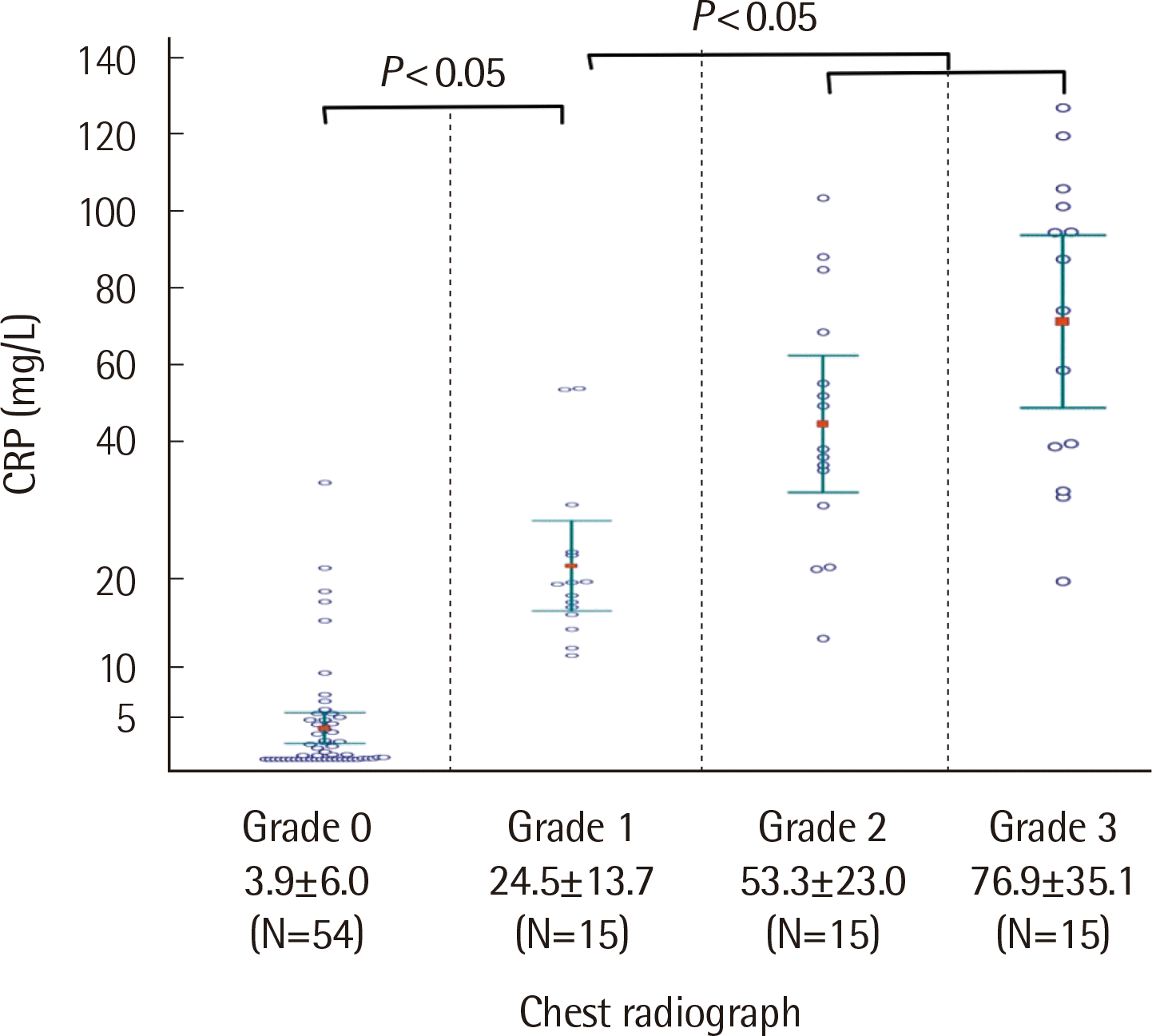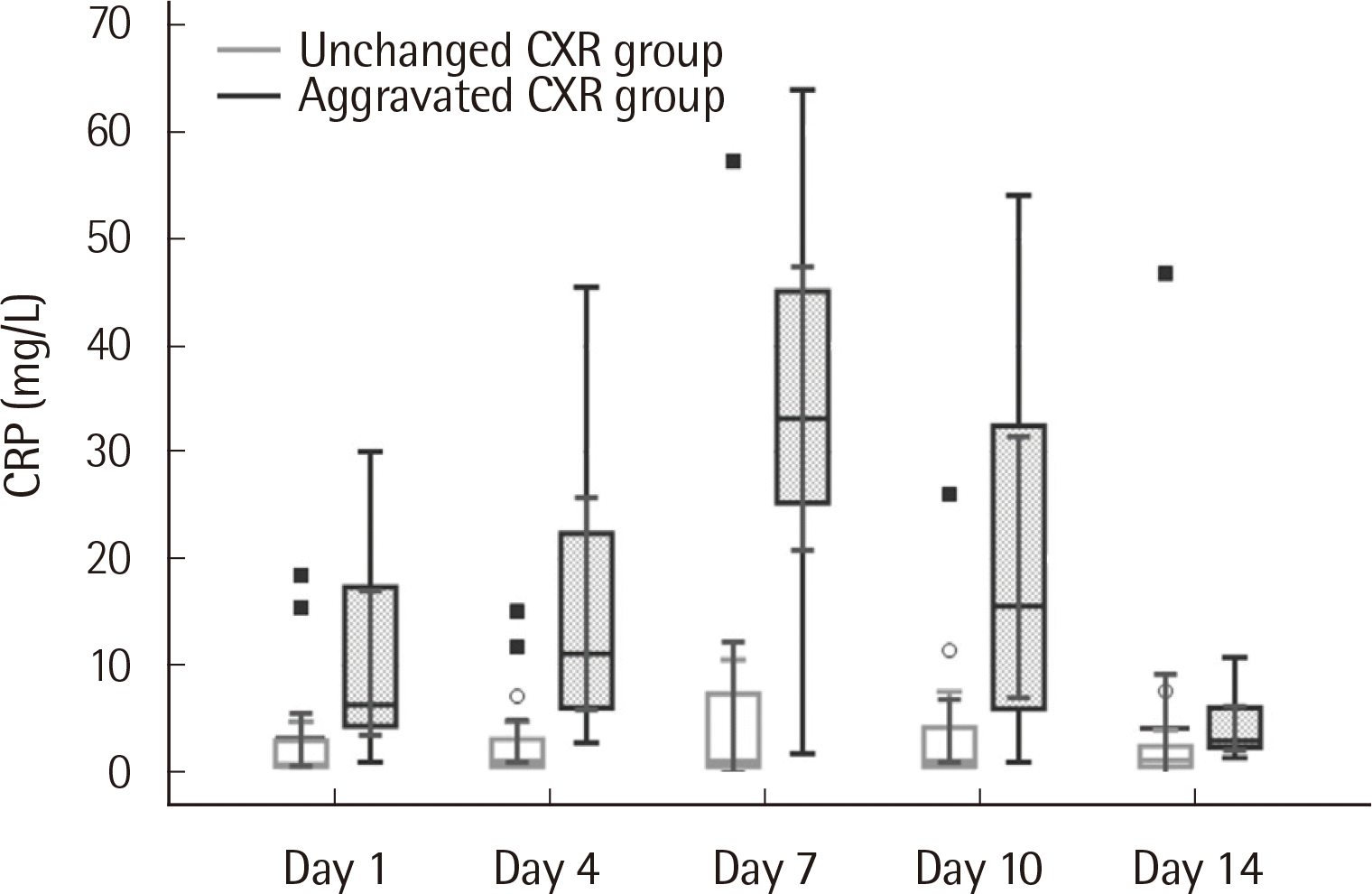1. Huang C, Wang Y, Li X, Ren L, Zhao J, Hu Y, et al. 2020; Clinical features of patients infected with 2019 novel coronavirus in Wuhan, China. Lancet. 395:497–506. DOI:
10.1016/S0140-6736(20)30183-5. PMID:
31986264. PMCID:
PMC7159299.



3. Matheeussen V, Van Hoof V, Loens K, Lammens C, Vanderstraeten A, Coenen S, et al. 2018; Analytical performance of a platform for point-of-care CRP testing in adults consulting for lower respiratory tract infection in primary care. Eur J Clin Microbiol Infect Dis. 37:1319–23. DOI:
10.1007/s10096-018-3253-3. PMID:
29744764.


4. Tan C, Huang Y, Shi F, Tan K, Ma Q, Chen Y, et al. 2020; C-reactive protein correlates with computed tomographic findings and predicts severe COVID-19 early. J Med Virol. 92:856–62. DOI:
10.1002/jmv.25871. PMID:
32281668. PMCID:
PMC7262341.


5. Chen W, Zheng KI, Liu S, Yan Z, Xu C, Qiao Z. 2020; Plasma CRP level is positively associated with the severity of COVID-19. Ann Clin Microbiol Antimicrob. 19:18. DOI:
10.1186/s12941-020-00362-2. PMID:
32414383. PMCID:
PMC7227180.



6. Bhargava A, Fukushima EA, Levine M, Zhao W, Tanveer F, Szpunar SM, et al. 2020; Predictors for severe COVID-19 infection. Clin Infect Dis. 71:1962–8. DOI:
10.1093/cid/ciaa674. PMID:
32472676. PMCID:
PMC7314166.


7. Shang W, Dong J, Ren Y, Tian M, Li W, Hu J, et al. 2020; The value of clinical parameters in predicting the severity of COVID-19. J Med Virol. 10:2188–92. DOI:
10.1002/jmv.26031. PMID:
32436996. PMCID:
PMC7280691.

9. Zeng F, Huang Y, Guo Y, Yin M, Chen X, Xiao L, et al. 2020; Association of inflammatory markers with the severity of COVID-19: A meta-analysis. Int J Infect Dis. 96:467–74. DOI:
10.1016/j.ijid.2020.05.055. PMID:
32425643. PMCID:
PMC7233226.



11. Liu Y, Yang Y, Zhang C, Huang F, Wang F, Yuan J, et al. 2020; Clinical and biochemical indexes from 2019-nCoV infected patients linked to viral loads and lung injury. Sci China Life Sci. 63:364–74. DOI:
10.1007/s11427-020-1643-8. PMID:
32048163. PMCID:
PMC7088566.



12. Litao MK, Kamat D. 2014; Erythrocyte sedimentation rate and C-reactive protein: how best to use them in clinical practice. Pediatr Ann. 43:417–20. DOI:
10.3928/00904481-20140924-10. PMID:
25290132.


14. Korppi M, Kröger L. 1993; C-reactive protein in viral and bacterial respiratory infection in children. Scand J Infect Dis. 25:207–13. DOI:
10.3109/00365549309008486. PMID:
8511515.


15. Zhao Y, Zhao Z, Wang Y, Zhou Y, Ma Y, Zuo W. 2020; Single-cell RNA expression profiling of ACE2, the receptor of SARS-CoV-2. Am J Respir Crit Care Med. 202:756–9. DOI:
10.1164/rccm.202001-0179LE. PMID:
32663409. PMCID:
PMC7462411.



16. Xu Z, Shi L, Wang Y, Zhang J, Huang L, Zhang C, et al. 2020; Pathological findings of COVID-19 associated with acute respiratory distress syndrome. Lancet Respir Med. 8:420–2. DOI:
10.1016/S2213-2600(20)30076-X. PMID:
32085846. PMCID:
PMC7164771.



17. Rodriguez-Morales AJ, Cardona-Ospina JA, Gutiérrez-Ocampo E, Villamizar-Peña R, Holguin-Rivera Y, Escalera-Antezana JP, et al. 2020; Clinical, laboratory and imaging features of COVID-19: A systematic review and meta-analysis. Travel Med Infect Dis. 34:101623. DOI:
10.1016/j.tmaid.2020.101623. PMID:
32179124. PMCID:
PMC7102608.

19. Li LQ, Huang T, Wang YQ, Wang ZP, Liang Y, Huang TB, et al. 2020; COVID-19 patients' clinical characteristics, discharge rate, and fatality rate of meta-analysis. J Med Virol. 92:577–83. DOI:
10.1002/jmv.25757. PMID:
32162702. PMCID:
PMC7228329.


21. Zheng HY, Zhang M, Yang CX, Zhang N, Wang XC, Yang XP, et al. 2020; Elevated exhaustion levels and reduced functional diversity of T cells in peripheral blood may predict severe progression in COVID-19 patients. Cell Mol Immunol. 17:541–3. DOI:
10.1038/s41423-020-0401-3. PMID:
32203186. PMCID:
PMC7091621.



22. Zheng M, Gao Y, Wang G, Song G, Liu S, Sun D, et al. 2020; Functional exhaustion of antiviral lymphocytes in COVID-19 patients. Cell Mol Immunol. 17:533–5. DOI:
10.1038/s41423-020-0402-2. PMID:
32203188. PMCID:
PMC7091858.

23. Chen N, Zhou M, Dong X, Qu J, Gong F, Han Y, et al. 2020; Epidemiological and clinical characteristics of 99 cases of 2019 novel coronavirus pneumonia in Wuhan, China: a descriptive study. Lancet. 395:507–13. DOI:
10.1016/S0140-6736(20)30211-7. PMID:
32007143. PMCID:
PMC7135076.








 PDF
PDF Citation
Citation Print
Print



 XML Download
XML Download